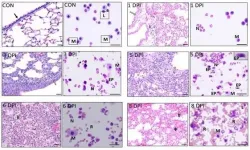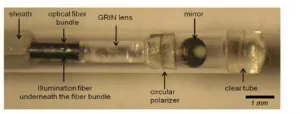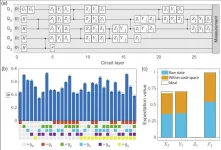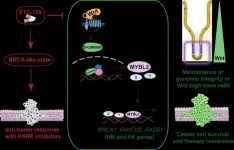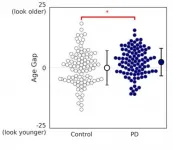How bacterial traffic jams lead to antibiotic-resistant, multilayer biofilms
New insight on the physical interactions that take place between swarming bacteria when exposed to antibiotics could lead to novel approaches for treating infections in patients
2021-03-16
(Press-News.org) The bacterial equivalent of a traffic jam causes multilayered biofilms to form in the presence of antibiotics, shows a study published today in eLife.
The study reveals how the collective behaviour of bacterial colonies may contribute to the emergence of antibiotic resistance. These insights could pave the way to new approaches for treating bacterial infections that help thwart the emergence of resistance.
Bacteria can acquire resistance to antibiotics through genetic mutations. But they can also defend themselves via collective behaviours such as joining together in a biofilm - a thin, slimy film made up of many bacteria that is less susceptible to antibiotics. Swarms of bacteria can also undergo a phenomenon similar to human traffic jams called 'motility-induced phase separation', in which they slow down when there are large numbers of bacteria crammed together.
"In our study, we wanted to see whether swarming bacteria can use physical interactions such as motility-induced phase separation to overcome certain stresses including exposure to antibiotics," says first author Iago Grobas, a PhD student at Warwick Medical School, University of Warwick, UK.
In their study, Grobas and colleagues exposed a colony of a common environmental bacteria called Bacillus subtilis to an antibiotic called kanamycin in a dish in the laboratory. They recorded a time-lapse video of the bacteria's behaviour and found that they formed biofilms in the presence of the drug.
Specifically, the team showed that the biofilm forms because bacteria begin to group together a distance away from the antibiotic, giving way to multiple layers of swarming bacteria.
"The layers build up through a physical mechanism whereby groups of cells moving together collide with each other," Grobas explains. "The collision generates enough stress to pile up the cells, which then move slower, attracting more cells through a mechanism similar to motility-induced phase separation. These multiple layers then lead to biofilm formation."
Next, the team tested a strategy to stop this formation and thereby prevent antibiotic resistance from occurring in this way. They found that splitting a single dose in two steps without changing the total amount of antibiotics strongly reduced the emergence of a biofilm.
The authors say further research is now needed to determine if bacteria that are harmful to humans use similar behaviours to survive antibiotic exposure. If they do, then future treatments should take these behaviours into account in order to reduce antibiotic resistance.
"Our discoveries question the way we use antibiotics and show that increasing the dosage is not always the best way to stop biofilm development," says co-senior author Munehiro Asally, Associate Professor at the School of Life Sciences, University of Warwick. "The timing of the bacteria's exposure to drugs is also important."
"These insights could lead us to rethink the way antibiotics are administered to patients during some infections," concludes co-senior author Marco Polin, Associate Professor at the Department of Physics, University of Warwick, and a researcher at the Mediterranean Institute for Advanced Studies (IMEDEA), Mallorca.
INFORMATION:
Media contact
Emily Packer,
Media Relations Manager
eLife
e.packer@elifesciences.org
+44 (0)1223 855373
About eLife
eLife is a non-profit organisation created by funders and led by researchers. Our mission is to accelerate discovery by operating a platform for research communication that encourages and recognises the most responsible behaviours. We aim to publish work of the highest standards and importance in all areas of biology and medicine, including the Physics of Living Systems, while exploring creative new ways to improve how research is assessed and published. eLife receives financial support and strategic guidance from the Howard Hughes Medical Institute, the Knut and Alice Wallenberg Foundation, the Max Planck Society and Wellcome. Learn more at https://elifesciences.org/about.
To read the latest Physics of Living Systems research published in eLife, visit https://elifesciences.org/subjects/physics-living-systems.
[Attachments] See images for this press release:

ELSE PRESS RELEASES FROM THIS DATE:
2021-03-16
The inclusion of a special new perovskite layer has enabled scientists to create a "spin-polarized LED" without needing a magnetic field or extremely low temperatures, potentially clearing the path to a raft of novel technologies.
Details of the research conducted at the National Renewable Energy Laboratory (NREL) and the University of Utah appear in the journal Science.
Researchers at NREL and around the world have been investigating the use of perovskite semiconductors for solar cells that have proven to be highly efficient at converting sunlight to electricity. Since a solar cell is one of the most demanding applications of any semiconductor, scientists are discovering other uses exist as well.
"We are exploring the fundamental properties of metal-halide ...
2021-03-16
Philadelphia, March 16, 2021 - A significant proportion of hospitalized patients with influenza develop complications of acute respiratory distress syndrome, driven by virus-induced cytopathic effects as well as exaggerated host immune response. Reporting in The American Journal of Pathology, published by Elsevier, investigators have found that treatment with an immune receptor blocker in combination with an antiviral agent markedly improves survival of mice infected with lethal influenza and reduces lung pathology in swine-influenza-infected piglets. Their research also provides insights into the optimal timing of treatment to prevent acute lung injury.
Previously, the investigators found ...
2021-03-16
WASHINGTON -- Researchers have developed a new intravascular imaging technique that could one day be used to detect coronary plaques that are likely to lead to a heart attack. Heart attacks are often triggered when an unstable plaque ruptures and then blocks a major artery that carries blood and oxygen to the heart.
"If unstable coronary plaques could be detected before they rupture, pharmacological or other treatments could be initiated early to prevent heart attacks and save lives," said research team leader Seemantini Nadkarni from the Wellman Center for Photomedicine at Massachusetts General Hospital. "Our new imaging technique represents a major step toward achieving this."
In The Optical Society (OSA) journal Biomedical ...
2021-03-16
MADISON, Wis. -- Millions of people are administered general anesthesia each year in the United States alone, but it's not always easy to tell whether they are actually unconscious.
A small proportion of those patients regain some awareness during medical procedures, but a new study of the brain activity that represents consciousness could prevent that potential trauma. It may also help both people in comas and scientists struggling to define which parts of the brain can claim to be key to the conscious mind.
"What has been shown for 100 years in an unconscious state like sleep are these slow ...
2021-03-16
Low doses of propylparaben - a chemical preservative found in food, drugs and cosmetics - can alter pregnancy-related changes in the breast in ways that may lessen the protection against breast cancer that pregnancy hormones normally convey, according to University of Massachusetts Amherst research.
The findings, published March 16 in the journal Endocrinology, suggest that propylparaben is an endocrine-disrupting chemical that interferes with the actions of hormones, says environmental health scientist Laura Vandenberg, the study's senior author. Endocrine ...
2021-03-16
Universal fault-tolerant quantum computing relies on the implementation of quantum error correction. An essential milestone is the achievement of error-corrected logical qubits that genuinely benefit from error correction, outperforming simple physical qubits. Although tremendous efforts have been devoted to demonstrate quantum error correcting codes with different quantum hardware, previous realizations are limited to be against certain types of errors or to prepare special logical states. It remains one of the greatest and also notoriously difficult challenges to realize a universal quantum error correcting code for more than a decade.
In a new research article published in the ...
2021-03-16
SINGAPORE, 16 March 2021 - ETC-159, a made-in-Singapore anti-cancer drug that is currently in early phase clinical trials for use in a subset of colorectal and gynaecological cancers, could also prevent some tumours from resisting therapies by blocking a key DNA repair mechanism, researchers from Duke-NUS Medical School and the Agency for Science, Technology and Research (A*STAR) in Singapore reported in the journal EMBO Molecular Medicine.
Among the many therapies used to treat cancers, inhibitors of the enzyme poly (ADP ribose) polymerase (PARP) prevent cancer cells from repairing naturally occurring DNA damage, including unwanted/harmful breaks in the DNA. When too many breaks accumulate, the cell dies.
"Some cancers have an overactive Wnt signalling pathway that may make them ...
2021-03-16
Non-orthogonal multiple access (NOMA) and millimeter-wave (mmWave) are two crucial techniques of 5G to meet the explosive capacity demands. On the other hand, UAVs deployed as aerial base stations are potential to provide ubiquitous coverage and satisfy users' multifarious requirements due to their flexibility and mobility. Nevertheless, the finite onboard energy is a fundamental limit of UAVs, which can deter the performance of UAV communication networks. Therefore, the researchers Xiaowei PANG and Nan ZHAO from Dalian University of Technology, Jie TANG and Xiuyin ZHANG from South China University of Technology, and Yi QIAN from University of Nebraska-Lincoln have focused on designing energy-efficient ...
2021-03-16
SAN ANTONIO -- March 16, 2021 -- One of the most profound discoveries in planetary science over the past 25 years is that worlds with oceans beneath layers of rock and ice are common in our solar system. Such worlds include the icy satellites of the giant planets, like Europa, Titan and Enceladus, and distant planets like Pluto.
In a report presented at the 52nd annual Lunar and Planetary Science Conference (LPSC 52) this week, Southwest Research Institute planetary scientist S. Alan Stern writes that the prevalence of interior water ocean worlds (IWOWs) in our solar system suggests they may be prevalent in other star systems as well, vastly expanding the conditions for planetary habitability and biological survival over time.
It has been known for many years that worlds like Earth, ...
2021-03-16
Parkinson's disease (PD) is a well-studied neurodegenerative disorder that affects between 7 and 10 million people worldwide. Despite PD being a recurrent topic in the medical literature for over 200 years, its mechanisms are largely unclear, and existing treatments are aimed at improving the patient's symptoms.
Among PD's most common symptoms are motor problems, including as tremors, slowness, and muscular rigidity. These, combined with many non-motor symptoms, cause many PD patients to develop facial abnormalities, such as face skin problems and difficulties making facial expressions. Such problems are not to be taken lightly, as one's face plays a crucial ...
LAST 30 PRESS RELEASES:
[Press-News.org] How bacterial traffic jams lead to antibiotic-resistant, multilayer biofilms
New insight on the physical interactions that take place between swarming bacteria when exposed to antibiotics could lead to novel approaches for treating infections in patients

